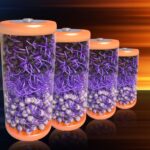 Imagine turning thin air into clean, drinkable water with just a bit of sunlight. That’s exactly what a team of scientists in Shanghai has achieved with their creation of the ‘hydrosponge.’ This innovative material pulls water from the air using far less energy than traditional methods, offering a fresh approach to water scarcity challenges.
Imagine turning thin air into clean, drinkable water with just a bit of sunlight. That’s exactly what a team of scientists in Shanghai has achieved with their creation of the ‘hydrosponge.’ This innovative material pulls water from the air using far less energy than traditional methods, offering a fresh approach to water scarcity challenges.
The hydrosponge, known as CPPY@LiCl, cleverly combines the water-holding capacity of hydrogels with the porous nature of sponges. This unique blend strikes a perfect balance between soaking up water and saving energy. It’s crafted from eco-friendly materials like chitosan, γ-polyglutamic acid, and polyvinylpyrrolidone. Plus, it includes polypyrrole, which helps turn sunlight into heat.
Designed with 70% of its structure as interconnected empty spaces, the hydrosponge makes it easy for water vapor to stick and move through. Lithium chloride, known for its moisture-attracting properties, boosts this process. Unlike other materials, CPPY@LiCl stores water in three states: tightly bound, loosely bound, and freely moving. This makes releasing the water much easier and less energy-intensive. In fact, it takes about 40% less energy to evaporate water compared to older methods, working efficiently with just the warmth of sunlight at 50°C (122°F).
During tests across different humidity levels, the hydrosponge showed impressive results. It could collect up to 4.21 grams of water per gram of material at 80% humidity. Outdoor experiments were even more promising, with the hydrosponge harvesting 6.29 liters of water per square meter overnight. It maintained 90% efficiency even under intense UV light. What’s more, the water it extracts meets World Health Organization standards for drinking.
Being primarily biodegradable, this hydrosponge offers a sustainable solution for areas without easy access to clean water. However, there’s still work to be done to make it more cost-effective and enhance its performance. This exciting development was recently detailed in the journal Advanced Functional Materials.








